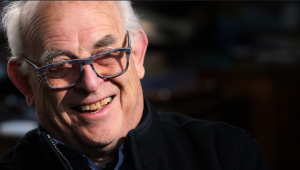Ralph Steadman: Godfather of Gonzo
Description
With his spindly, whimsical characters, illustrator Ralph Steadman created one of the most identifiable visual styles of the 20th century.
Featured Artists

Ralph Steadman is a renowned illustrator known for his distinctive style and his longtime collaboration with writer Hunter S. Thompson.
Steadman was born in England in 1936 and attended East Ham Technical College and the London College of Printing. He was working as a freelance illustrator when he received an assignment to accompany Thompson to the 1970 Kentucky Derby for Scanlan’s Monthly. The resulting article featuring Thompson’s quirky narrative and Steadman’s signature sketches is credited with kicking off the satirical gonzo style of journalism. The pair would work together for the next fifteen years, including on Thompson’s notable 1971 novel Fear and Loathing in Las Vegas.
Steadman’s spindly figures, ink blotted canvases, and whimsical imagery has also graced numerous books, album artwork, advertisements, and performance posters. Among his best-known work, he designed the art for cult 1987 film Withnail and I, won a Francis Williams Book Illustration Award for illustrations to a 1967 edition of Alice in Wonderland, and created the labels for Flying Dog beer.
Transcript
Ralph Steadman created one of the most identifiable visual styles of the 20th century. His contributions to journalism, commerce, and the world of art, have made him a cultural icon, but when he was first starting out as a small time political cartoonist, he didn’t have an inkling of what his life had in store, only a burning ambition.
Ralph Steadman: I wanted to change the world. It was my idea as a cartoonist. And I believe now say 60 years later I’ve succeeded, because it’s worse than it was when I started.
Steadman’s signature characters spindly and grotesque, yet weirdly whimsical, nod to a dark sense of humor, forged a long time ago. At age four, Steadman lived through the Nazi blitz on London. For eight months, he was routinely jostled out of bed to take cover in bomb shelters, and for years after he was plagued by nightmares that defined his worldview and his drawings. But today, Ralph Steadman is not a dour-figure. The 83-year-old exudes levity and joy. It’s the kind of jolly sense of humor you can afford to have if you’ve accomplished all you set out to do, though it was a long journey for Steadman. In 1959 he landed his first staff gig as a cartoonist for the Kemsley newspaper group and throughout the 60s, steadily built his reputation, freelancing first at Punch, and later for the likes of Rolling Stone, Private Eye, and The New York Times. In 1969, he published his first book of cartoons Still Life with Raspberry. Then he got a life changing offer to cover the 1970 Kentucky Derby with Hunter S. Thompson. The original bad boy of journalism had already made a name for himself with Hell’s Angels, a book about a year he spent with the infamous motorcycle gang. His subjective take on reporting earned a nickname that came to define his often reckless style, Gonzo, a word borrowed from Portuguese.
Steadman: It means hinge. So, I guess if you’re unhinged, you’re kind of gonzo.
Steadman regularly collaborated with Thompson until the mid-1980s, and though iconic, those images represent but a small fraction of the illustrator’s output. Of his 39 books, some are about history’s greatest thinkers, others lighthearted and fanciful. Still more capture distinct chapters in Steadman’s artistic journey, like Paranoids, a series of disturbing Polaroids made using a technique Steadman discovered by chance on a summer’s day in Turkey.
Steadman: It was very hot there, and I remember the morning, getting up and taking a picture of the sun coming up on a very still morning and the light of the sun coming across the sea. And I got a pencil with me, and I sort of did that across it like you do, like that. And it moved. And I went wow this is amazing, I can use this, do caricatures and things. That’s when I found that out, in ’86 I think it was.
Ralph Steadman has never been intimidated by the blank page. Indeed, his signature style is defined by the confidence and enthusiasm he starts every project with.
Steadman: I mean if it isn’t, in some extent, fun, what’s the point in doing it? So, I don’t use a pencil first and I just go straight in with ink, and people say, “Well, don’t you make a mistake?” And I say, “Well, there’s no such thing as a mistake. A mistake is an opportunity to do something else.”
Today, Ralph Steadman continues to add to his epic body of work, still finding pleasure in each new creation.

